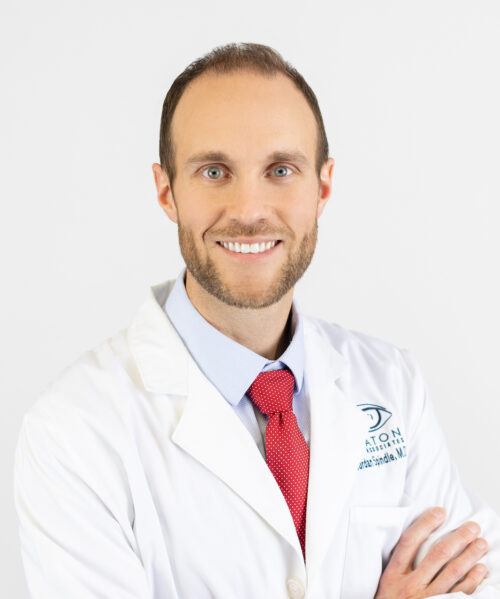Oculoplastic Services
for Patients in Tyler, Athens, Longview, TX & All of East Texas
Jordan Spindle, M.D. is a Board Certified Ophthalmologist with a two-year fellowship in Oculofacial plastic surgery. Dr. Spindle completed his undergraduate degree in Biomedical Sciences at Texas A&M University and completed medical school at the University of Texas at Houston. He completed an internship at John Peter Smith Hospital in Fort Worth, his residency in Ophthalmology at SUNY Downstate in Brooklyn, NY, and was chosen from a highly competitive field of applicants to train for two years as an American Society of Ophthalmic Plastic and Reconstructive Surgery (ASOPRS) fellow at the prestigious UAB Callahan Eye Hospital in Birmingham, AL.
Dr. Spindle brings exceptional credentials, experience and a wide variety of oculoplastic services to patients in Tyler, Athens, Longview, Beaumont, Bryan, College Station, Conroe, Dallas, Houston, Jacksonville, TX, and all of East Texas. From eyelid surgery to reconstructive procedures, eyebrow lifts, and more, our certified opticians have the cosmetic experience to help you. With his conservative approach, his patients enjoy a more youthful appearance with impressive, yet very natural results.
Contact our offices today to learn more about the range of oculoplastic solutions we offer and to schedule an appointment! We look forward to helping you transform your appearance and vision!
Experience Matters
When choosing your surgeon, it is extremely important to look for a cosmetic and reconstructive facial surgeon. Dr. Spindle is a Board Certified Ophthalmologist with extensive training. In fact, he’s the ONLY two-year fellowship trained Oculofacial plastic surgeon in the area and is a member of the American Society of Ophthalmic Plastic and Reconstructive Surgery.
Upper Blepharoplasty
Lower Blepharoplasty
Eyelid Surgery (Blepharoplasty)
Your eyes are usually the first things that people notice about your appearance. They are probably the most important aspect of facial attractiveness. Even with a good night’s sleep, you can look tired, sad or older than you are with loose skin over the eyes or even fat bags under the eyes. As we go through life, even if we have taken care of ourselves, the skin around our eyes stretches and wrinkles. Fatty deposits cause the upper lids to sag while under the eye the tissue can bulge forward and become discolored. In severe cases, vision can become partially blocked. Typically, these unwanted characteristics come with age, beginning in the late 30s and early 40s, but hereditary factors can cause a much younger person to appear prematurely aged. Use of alcohol, smoking and poor diet all accelerate the signs of aging.
Due to major advances in an eyelid rejuvenation procedure called blepharoplasty, your doctor can help restore a more youthful, alert and healthy look to your eyes. Sometimes referred to as a “mini-face lift”, blepharoplasty has become one of the most popular cosmetic procedures for both men and women because of its high level of patient satisfaction. Blepharoplasty can be performed on both the upper and lower eyelids.
As a general rule, insurance does not cover cosmetic surgery. However, if your eyelids are encroaching upon your field of vision, the procedure may be covered as “medically necessary” surgery.
Upper Blepharoplasty (eyelid lift) – Removes extra skin above the eyelid to achieve a more youthful look, and often improves vision. Dr. Spindle takes a conservative approach, ensuring you achieve a natural appearance and can close your eyes properly.
Lower Blepharoplasty (eye bags) – Can effectively and permanently eliminate under eye puffiness for a more awake, youthful appearance.
Ptosis
What is Ptosis?
Ptosis is drooping of the eyelid.
Who Gets Ptosis?
Ptosis can occur at any age, but is seen most commonly in adults. A drooping eyelid can fall across the pupil and interfere with vision. Patients often report that their vision is better by manually elevating the eyelid margin with their fingertips. When a drooping eyelid affects the vision, it can be repaired. In adults, the usual cause of a drooping eyelid, or ptosis, is a broken muscle tendon in the eyelid.
Children can be born with or develop ptosis at a young age, giving them asymmetrical or low-set eyelids. In some cases, visual development can be impaired due to ptosis in children. An eye examination is necessary early in life when children have congenital ptosis. Children with congenital ptosis need to be monitored and vision assessed during the first years in life. If the vision is not affected, congenital ptosis repair is usually planned between 3 and 5 years of age.
What to Expect During Your Ptosis Consultation
Dr. Spindle will spend time with you discussing your medical history and medications as well as doing a complete facial and visual examination. Blood thinners and other medications will be discussed at this time.
Dr. Spindle will take measurements and photographs to aid in the surgical planning and evaluation as there are different techniques utilized in ptosis repair. Because every patient is different, Dr. Spindle will then formulate a customized treatment plan with options that will provide you with the best results. This includes discussing what you want to achieve with surgery, along with any risks that may be involved.
What to Expect the Day of Your Procedure
In adults, the repair of ptosis involves an outpatient procedure under IV sedation with local anesthesia. If the condition is present in both eyes, they can be done at the same time. Patient cooperation during the procedure is essential to optimize the eyelid height, contour and symmetry. The surgery is typically painless and lasts approximately 90 minutes.
In children, this type of surgery is performed under general anesthesia as an outpatient procedure.
Call (800) 762-5787 for more information or to click below to schedule a consultation with Dr. Spindle.
Procedures For Age-Related Changes
There are many changes as we age that can occur in and around the eye area that may not only affect your physical appearance but impact your vision as well. Dr. Jordan Spindle has extensive training and experience performing a variety of surgical procedures to help correct age-related changes to the eye area. In fact, Dr. Spindle is the ONLY two-year fellowship trained oculofacial and plastic surgeon in the area and has been inducted into the American Society of Ophthalmic Plastic and Reconstructive Surgery.
Two common age-related changes to the eye area that he can correct are Ectropion and Entropion.
Ectropion (lower eyelid turning out)
Ectropion is a medical condition in which the lower eyelid turns or sags outward, away from the eye, exposing the surface of the inner eyelid. This condition may cause dry eyes, excessive tearing, sensitivity to light and irritation. Artificial tears and lubricating ointments can help relieve symptoms of ectropion. Because ectropion leaves the cornea irritated and exposed, it becomes more susceptible to drying which could results in abrasions or corneal ulcers if left untreated. For full ectropion relief, surgery is usually needed to correct the condition.
When to see a doctor
If your eyes are consistently watering or irritated, or your eyelids seems to be sagging or drooping, it is a good idea to consult with a skilled ophthalmologist who can help recommend the proper course of treatment.
Entropion (lower eyelid turning in)
Entropion is a medical condition in which the eyelid (usually the lower lid) folds inward. This condition may be very uncomfortable, as the eyelashes tend to continuously rub against the cornea causing persistent irritation and discomfort. Entropion can also cause redness, sensitivity to light, watery eyes, discharge and the sensation that something is in your eye. Entropion is more common in older adults and generally affects only the lower eyelid.
Artificial tears and ointments can help relieve symptoms. But surgery is typically recommended to fully correct this condition. If left untreated, entropion can cause damage to the cornea and eye infections if left untreated.
When to see a doctor
If you feel like you constantly have something in your eye or notice that your eyelashes seen to be turning inward toward your eye, it’s time to consult with an ophthalmologist. If untreated, entropion can cause permanent damage to the eye.
Tearing (Epiphora)

What Causes Tearing (Epiphora)?
Tearing is a common complaint, and is due to either overproduction of tears or inadequate drainage of tears. One of the most common problems is an obstruction of the nasolacrimal outflow tract, which carries the tears away from the eye. When the nasolacrimal outflow tract is blocked, tearing can occur because there is no way for the tears to naturally drain away from the eye. In some cases, infection can occur, leading to dacryocystitis and the need for more rigorous medical and surgical therapy.
Who Gets a Nasolacrimal Duct Obstruction?
Tearing in adults can be caused by a variety of underlying problems. When a blockage of the nasolacrimal outflow tract is present, surgery may be necessary to reconstruct a new pathway for the tears to drain into the nose. A dacryocystorhinostomy (DCR) is a common procedure in which the nasolacrimal tract is rerouted around an obstruction. This procedure has a very high chance of success.
In children with congenital blocked tear ducts, the condition often will spontaneously correct itself by one year of age. If the tearing does not resolve, either probing or placement of a stent can be performed with a very high degree of success.
What to Expect at Your Consultation
Dr. Spindle will spend time with you discussing your medical history and medications, as well as performing a complete facial and visual examination. There are some diseases and medications that may be causing an obstruction of the nasolacrimal duct. Blood thinners and other medications will also be discussed, along with risks, benefits and alternatives for your specific condition.
What to Expect the Day of Your Procedure
Most tear duct surgery is done under local anesthesia in an outpatient surgery center. Your procedure will take approximately 30 minutes to one hour, after which you will recover in the post-operative area before going home.
Your Recovery
After your surgery, you may experience swelling and bruising in the area around your eye, as well as a mild nose bleed. Cold packs are encouraged in the first few days to help aid in your recovery. You can shower and perform most normal activities the next day. Main restrictions include no nose blowing, no makeup on the suture line and no heavy lifting or exercise for one week. Dr. Spindle will see you approximately one week after your procedure for a checkup.
Reconstructive Procedures
There are many medical reasons patients need a reconstructive procedure. When dealing with the eye area, choosing an experienced practice with a surgeon specially trained in this area is important. Dr. Spindle has extensive training and experience performing reconstructive surgery in the eye region. In fact, he is the ONLY two year fellowship trained oculofacial and plastic surgeon in the area, and has been inducted into the American Society of Ophthalmic Plastic and Reconstructive Surgery.
If you have been diagnosed with, or are suffering with any of the following conditions, Dr. Spindle’s areas of specialty also include the following procedures:
Brow Lift
A brow lift, also known as a forehead lift, is a cosmetic procedure to improve the appearance of the forehead, brow and area around the eyes to create a more alert, youthful look. A brow lift reduces horizontal wrinkle lines on the forehead, as well as those that occur on the bridge of the nose, between the eyes. A brow lift will also improves frown lines, the vertical creases that develop between the eyebrows. Sagging and drooping brows are elevated in a more alert and youthful position.
Why Consider a Brow Lift?
Many people choose to have a brow lift when they become unhappy their appearance becuase of h the wrinkles across their forehead or eyes, or if their eyebrows begin to droop or sag. With age, the lines across the forehead and between the eyes begin to deepen. Skin and soft tissues lose elasticity, and the distance between brows and lashes shortens. This combination of low eyebrows and deep creases can make you look tired, angry or sad. A brow lift can soften facial lines, raise the eyebrows and restore a softer, more pleasing appearance.
Call (800) 762-5787 for more information or to click below to schedule a consultation with Dr. Spindle.



























